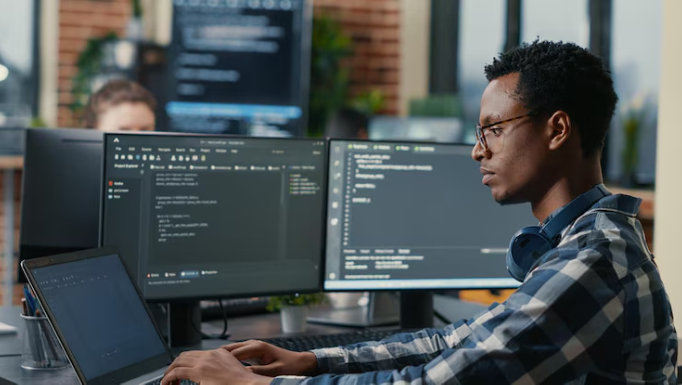Ever wondered how everyday devices like smart thermostats, fitness trackers, or even your coffee machine can be part of a connected system that responds intelligently? That’s the beauty of the Internet of Things, or IoT, working hand in hand with modern computing. What once seemed futuristic is now a part of daily life—and it’s all thanks to the powerful connection between smart devices and advanced computing technologies.
IoT is more than just a buzzword. It’s about how machines talk to each other and share data in real time, all while making our environments smarter and more efficient. From homes and hospitals to industries and cities, the way IoT blends with computing continues to shape how we live and work.
What IoT Means in Today’s World
IoT refers to the growing network of physical devices that are connected to the internet. These devices collect, send, and sometimes act on data without needing constant human input.
Think of a smart light bulb that turns off when no one’s in the room or a fitness band that tracks your steps and syncs them to your phone. These actions rely on sensors, data transmission, and decision-making software—all powered by modern computing.
The Backbone: Modern Computing in Action
Modern computing gives IoT devices the power they need to function effectively. It includes everything from powerful cloud servers to edge goal55 computing devices that process data close to where it’s generated. The cloud allows for large-scale storage and analysis, while edge computing ensures that decisions can be made quickly and locally.
This setup allows IoT to respond instantly and efficiently. For example, a self-driving car can’t wait for cloud data to tell it when to brake. It needs computing at the edge to make split-second decisions using sensors and local processors. At the same time, it sends data to the cloud for broader analysis, updates, and improvements.
Real-Life Connections Between IoT and Computing
Smart homes are one of the easiest examples of this relationship in action. From lights and locks to speakers and appliances, everything is connected through a network. You can control your home with voice commands, automate routines, and even monitor energy usage—all because IoT devices are working with smart computing platforms.
In industries, IoT has made manufacturing more precise and efficient. Machines now predict when they’ll need maintenance, adjust operations for better energy use, and collect data that helps improve productivity. This is possible because modern computing platforms are constantly analyzing incoming information and sending back smarter instructions.
How IoT Is Reshaping Computing Itself
It’s not just that computing supports IoT—IoT is also reshaping how computing works. Because so many devices are generating data all the time, computing systems have adapted to handle this steady flow. This means more use of edge computing, more powerful AI systems, and more emphasis on real-time processing.
The shift to handle IoT demands has led to creative solutions. Developers now create lightweight software that runs smoothly on small devices. Data scientists design smarter ways to filter and prioritize information. And engineers build systems that are more energy-efficient and reliable, even when managing thousands or millions of devices at once.
The Role of AI in Making Things Smarter
Artificial Intelligence plays a huge part in how IoT and computing work together. It helps devices learn from patterns, make better decisions, and even predict future actions. For instance, a smart thermostat can learn your daily routine and adjust the temperature automatically. It does this by analyzing data and finding trends—all thanks to AI-driven computing.
In more advanced cases, AI helps identify traffic patterns, monitor supply chains, or detect early signs of equipment issues in factories. These insights come from combining IoT sensors with computing systems that can think and adapt over time.
Making Everyday Life Smoother and Smarter
At the personal level, IoT, combined with modern computing, makes life easier and more connected. Your phone can talk to your car, your refrigerator can help you build a shopping list, and your home can be ready for you before you even walk in the door.
For businesses, it means better customer service, lower operating costs, and smarter planning. Data collected from goal55 login IoT systems helps businesses make informed choices and provide more personalized experiences. Whether it’s a store tracking inventory or a hotel adjusting room temperature before guests arrive, the impact is practical and positive.
In cities, smart systems manage everything from traffic signals to energy grids. These improvements make urban life smoother and help build sustainable communities, all thanks to the steady flow of data and the computing power that makes sense of it.
Security and Reliability in the Mix
With more connected devices comes more responsibility. That’s why security and system reliability are key parts of the relationship between IoT and computing. Devices need to protect data, prevent unauthorized access, and continue operating smoothly no matter what.
Modern computing platforms support these goals through encryption, regular updates, and secure communication protocols. Many systems are now designed to spot and respond to threats in real time, which helps keep everything running safely.
As technology continues to improve, the focus on secure and stable systems will only grow stronger, ensuring that users can enjoy all the benefits without worry.
Looking Ahead to More Possibilities
The connection between IoT and modern computing is only getting stronger. As both areas develop, new ideas continue to emerge. We may see more use of voice interfaces, smarter cities with real-time adjustments, and even better healthcare tracking at home. All of this is powered by the same simple idea—devices collecting data and computing systems making that data useful.
Final Thoughts
The relationship between IoT and modern computing is one of balance and progress. IoT brings the data and the real-world interaction. Modern computing brings the processing power, intelligence, and structure to make that data meaningful. Together, they form a system that improves daily life, supports businesses, and creates smarter environments across the globe.

